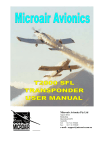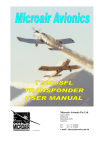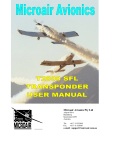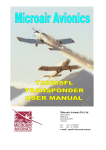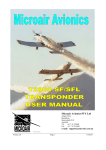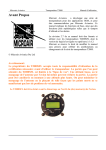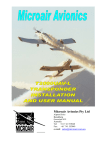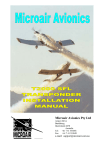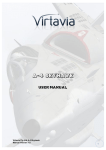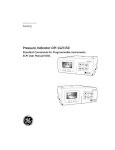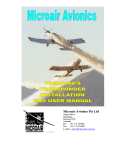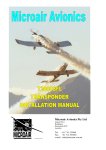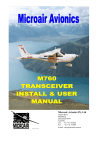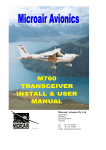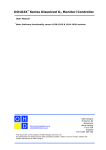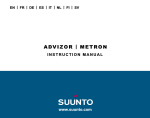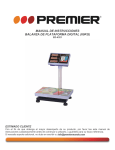Download ATSO document version 1
Transcript
Microair Avionics Pty Ltd Airport Drive Bundaberg Queensland 4670 Australia Tel: Fax: +61 7 41 553048 +61 7 41 553049 e-mail: [email protected] About This Document Microair Avionics has developed a series of transponders for use with OEM applications, and for commercial sale by Microair Avionics. The manual explains the basic functions and elaborates on the more sophisticated features, such as altitude display and alerts. Revision 2.8 of this manual is to be supplied and used in conjunction with T2000SFL transponders with software version 1.6.3, or later. Microair reserves the right to amend this manual as required, to reflect any enhancements or upgrades to the T2000 Transponder series. © Microair Avionics Pty Ltd Statement: The T2000SFL owner accepts all responsibility for obtaining the proper licensing before using the transponder. The coverage you can expect from the T2000SFL is limited to “line of sight”. Low altitude or aircraft antenna shielding by the aircraft itself may result in a reduced range. Range can be improved by climbing to a higher altitude. It may be possible to minimize antenna shielding by locating the antenna where dead spots are only noticed during abnormal flight attitudes. The T2000SFL should be turned off before starting or shutting down aircraft engine(s). MICROAIR DOCUMENTS Microair T2000 Users Manual Microair T2000 Installation Manual Microair T2000 Flight Manual Supplement Microair T2000 Service Manual Microair T2000 User Manual Supplement (use with user manual 2.5) T2000-DOC-001 T2000-DOC-002 T2000-DOC-003 T2000-DOC-004 T2000-DOC-005 DOCUMENT REVISION STATUS – T2000-DOC-001 Revision 1.0 2.2 2.3 2.4 2.5 2.6 2.7 2.8 Date 11/02/01 11/07/01 22/08/01 05/10/01 12/10/01 07/11/01 01/06/02 22/11/03 Change Initial Draft Voltage Monitoring Standby function added Hi / Lo alerts added Mode and Program Mode menu functions amended Deleted SF references Assigned Alt & Buffer Alt input amended, Name/Reg relocated to end of Program Mode ID and VFR key instructions amended TABLE OF CONTENTS 1.0 INTRODUCTION.............................................................................................4 1.1 1.2 1.3 1.4 1.5 1.6 T2000 CONTROLS ..................................................................................................................6 TURNING ON..........................................................................................................................6 BACKLIGHTING ....................................................................................................................6 TURNING OFF ........................................................................................................................6 TRANSPONDER OPERATION ..............................................................................................7 DISPLAY LAYOUT ................................................................................................................7 2.0 DISPLAY FUNCTION.....................................................................................8 3.0 CONTROL FUNCTIONS ................................................................................9 3.1 3.2 3.3 3.4 SELECTMODE KNOB ............................................................................................................9 CODE SELECT KNOB..........................................................................................................10 ON KEY..................................................................................................................................10 MODE KEY............................................................................................................................11 3.4.1 3.4.2 3.4.3 3.4.4 3.4.5 3.4.6 QNH OR BARO (BAROMETRIC PRESSURE)................................................................................................... 12 ASSIGNED (ALTITUDE)...................................................................................................................................... 13 BUFFER ALT ......................................................................................................................................................... 14 ALTITUDE (UNITS).............................................................................................................................................. 15 VOLTAGE .............................................................................................................................................................. 16 ALERT TONE......................................................................................................................................................... 17 3.5 3.6 3.7 3.8 ENTER KEY...........................................................................................................................18 TOGGLE KEY .......................................................................................................................18 VFR – HOT KEY ...................................................................................................................19 ID KEY ...................................................................................................................................19 4.0 INTIALISATION AND SETUP ....................................................................20 4.1 PROGRAM MODE ................................................................................................................20 4.1.1 4.1.2 4.1.3 4.1.4 4.1.5 4.1.6 4.1.7 4.1.8 4.1.9 4.1.10 VOLT MON ............................................................................................................................................................ 21 A/C VOLT............................................................................................................................................................... 21 O/V SET .................................................................................................................................................................. 21 U/V SET .................................................................................................................................................................. 22 E/C POW ................................................................................................................................................................. 22 VFR CODE ............................................................................................................................................................. 22 BARO ...................................................................................................................................................................... 23 REM STBY ............................................................................................................................................................. 23 NAME /REG (ONE TIME ONLY ENTRY).......................................................................................................... 24 EXIT PROGRAM ................................................................................................................................................... 24 5.0 FREQUENTLY ASKED QUESTIONS:.......................................................25 6.0 LIMITED WARRANTY ................................................................................27 1.0 INTRODUCTION The Microair T2000 Transponder is designed to operate in the environment of a Radar Beacon System. This system interrogates the transponder, which in turn replies with an identity code and altitude information. The radar system consists of a network of ground stations, which sweep the horizon like a conventional radar. When the transponder in the aircraft detects the radar sweep (is illuminated), the transponder replies with a burst transmission giving its identity code and altitude. The aircraft’s transponder receives the ground station signal asking it to transmit. The transponder “replies” with the code, and if operating in mode C, the encoder altitude. Ground stations sweep the sky with a signal, which asks the transponder in the aircraft to transmit its code and altitude. The system presents the replies from all transponders in range of the ground stations on a single display screen. This allows ATC to easily locate, identify, and see the altitude of all traffic in their airspace. A transponder’s reply is termed a squawk. Hence the current code being used by the transponder is termed the squawk code. At times of high airspace activity, ATC may wish to uniquely identify an individual aircraft with a request to squawk ident. The pilot uses the ident control on the transponder to make the transponder’s squawk on the ATC display flash for a short period. The ident control should not be used unless ATC request it. ATC will issue a code to an aircraft requesting entry into its controlled airspace. This code is normally unique for each aircraft, each time that aircraft passes through the airspace. The code is 4 digits long, and each digit can range from 0-7. There are several special codes, which are used to identify General Aviation aircraft, and some special situations which aircraft could encounter. Misuse of these codes may result in legal charges against the user. IMPORTANT NOTE ALWAYS check the standby code, BEFORE transferring it to the ACTIVE position. 0000 1200 2000 3000 7000 7500 7600 7700 7777 General Purpose code subject to regional agreement Civil VFR Flights OCTA not participating in Radar Information Service (RIS). General Aviation Code (US and other countries) Civil IFR Fights OCTA not participating in RIS Civil Flights in Controlled airspace VFR General Aviation Code (Europe) Unlawful Interference Code Radio Communications Failure Emergency Code Military Intercept Code (NEVER USE) Code 2100 is a test code that can be used by qualified personal to test the transponder to ATC. The user should check the Civil Aviation Rules/Regulations to determine the VFR General Aviation transponder code for their country. 1.1 T2000 CONTROLS All of the T2000’s functions and features can be accessed from the controls on the front face. CONTROL 1 2 3 4 5 6 7 8 DESCRIPTION ON Key MODE Key ENTER Key IDENT Key TOGGLE Key CODE SELECT Knob SELECTMODE Knob VFR Key 1.2 TURNING ON The T2000 is turned on by pressing the ON key. The T2000 will go through a start up routine displaying self test messages, and ending with the operational display. The backlighting is also tested during start up. ON KEY 1.3 BACKLIGHTING The T2000SFL has an LCD display which is backlit. The backlighting has a low and a high brightness level to enhance the display in low light conditions, and darkness. When the T2000 is first turned on there is no backlighting. Press the ON key again – Low level Backlighting comes on. Press the ON key again – High level Backlighting comes on. Press the ON key again – Display returns to no backlighting 1.4 TURNING OFF The T2000 is turned off by holding down the ON Key. The word SHUTDOWN is displayed and the T2000 counts down from 3-0, then turns off. If the ON Key is lifted before the count is finished, the T2000 returns to the operational screen. ON KEY 1.5 TRANSPONDER OPERATION The transponder can be operated in the following modes: ON ALT Transponder operates in mode A where only the active code is sent. Transponder operates in mode C where both the active code and the encoder altitude are sent. If requested by ATC the user can squawk ident (ID key). The transponder will add an extra piece of data to the transmission, to make the code and altitude information flash on the ATC radar display. When operating in ALT mode, altitude data is received from a separate altitude encoder. This data is passed back to the transponder to be included in the response transmission to ATC. The Microair T2000 is compatible with any industry standard altitude encoder, with parallel output. The display can present the active and standby codes. The standby code can be changed at any time, and then toggled to become the active code. The T2000 can replace the standby code with the encoder altitude, or supply voltage. In addition to the required TSO functions, the Microair T2000 offers a number of other useful features, which can be displayed by the operator either as a pop-up message, audio beep, or a display option. 1.6 DISPLAY LAYOUT The Microair T2000 SFL is a 57mm diameter face version to fit the standard 2 ¼ inch instrument hole. The mounting is by 4 x M4 machine screws, located through the panel and screwed into threaded holes in each corner of the transponder’s front face. IMPORTANT NOTE Use only the factory supplied screws or M4 x 12mm machine screws. Do NOT oversize the holes, or use over-length screws. These actions may damage internal components of the transponder. Microair T2000 SFL 2.0 DISPLAY FUNCTION The SFL is a dual line display of 8 characters each, with the active code on the top line, and the standby code on the bottom. The display is LCD, with preset backlighting. STANDBY Neither code or altitude are sent Active Code The transmitted code MODE A Transmit ON – Only code sent I character Squawk Ident operation R character Normal reply operation MODE C Transmit ON – Code and altitude sent Standby Code Never Transmitted PA Pressure Altitude Encoder Altitiude F Feet Altitude units are in Feet Q QNH or Barometric Altitude Adjusted Encoder Altitude M Metres Altitude units are in Metres FL Flight Level Altitude units are in Flight Levels Displayed Altitude Altitude generated by Encoder, and may be adjusted for barometric pressure (QNH/Baro) When the altitude is displayed, the standby code is saved into memory. To display the standby code again, press the toggle key once to make it appear on the bottom line. Press the toggle key again to exchange the active and standby codes. After 10 seconds of inactivity, the lower line will revert to displaying the altitude. Pressure Altitude (PA) is the Encoder altitude. The encoder’s barometric adjustment is preset to 1013 millibars (29.92HG). If the Encoder is not powered or not fitted, the message NO ALT will appear on the display. It is possible to input the QNH / Baro (barometric pressure) given by ATC, into the T2000 to adjust the displayed pressure altitude. This feature will allow the user to adjust the displayed altitude to read the same as the aircraft’s altimeter. IMPORTANT NOTE When passing upwards through the transition level/layer, the altimeter and transponder should both be set to 1013mb (29.92HG). When passing down through the transition level/layer, the altimeter and transponder are reset to the QNH/ Baro (barometric pressure) given by ATC. The T2000 will transmit the encoder altitude (pressure altitude) only, in accordance with normal mode C operation. The adjusted QNH / Baro altitude is never transmitted. 3.0 CONTROL FUNCTIONS This section describes the transponder control keys and their functions. Many of the control keys have more than one function, and some keys access multi-option menus, which can be scrolled. 3.1 SELECTMODE KNOB The SELECTMODE knob allows the user to switch the transponder between the 4 operating modes. Selectmode Knob STANDBY In standby the transponder is powered up, but will not transmit. ON On the active display line the letter S appears on the left hand side. Will reply to Mode A and C interrogations, but with no mode C encoder information. Mode C blind encoder is normally powered up in this mode, but can be powered down if encoder power option is set OFF (refer E/C POW in Initialisation and Setup section). ALT On the active display line the letter A appears on the left hand side. Will reply to Mode A and C interrogations, with the mode C encoder information. In the absence of a valid encoder input, only the C framing pulse will be sent. ALT DISPLAY On the active display line the letter C appears on the left hand side. The standby code is replaced with the encoder altitude. If the pressure has been set via the QNH / Baro option of MODE MENU, the displayed altitude will be adjusted for barometric air pressure. Altitude will be displayed in units set in ALTITUDE option of MODE MENU. The DISPLAY ALT only displays altitude if a valid encoder input is being received. When climbing above the transition level/layer, the user must reset the transponder at the same time as the aircraft’s altimeter to 1013mb or 29.92HG. On the active display line the letter C appears on the left hand side. Examples of encoder altitude Examples of pressure adjusted encoder altitude 3.2 CODE SELECT Knob The CODE SELECT knob can be rotated clockwise to scroll upwards, and counter-clockwise to scroll downwards. Each digit of the code is adjusted separately. The adjust function starts with the left hand digit, and is moved across to the next digit by pushing the CODE SELECT knob inwards. After 10 seconds of inactivity the cursor will revert to the left hand digit. Code Select 3.3 ON KEY Refer to TURNING ON section for basic operation. The ON key tuns on the T2000 and adjusts the back lighting. To turn off the T2000, the ON key is held down. The display counts down from 3 to 0 then turns off. On Key 3.4 MODE KEY The MODE key can be used to access two separate menus: Mode Key • If the transponder is turned on, by holding down the MODE key, and pressing the ON key, the T2000 will start in PROGRAM MODE. The MODE key must be held down, until the start-up self-test messages have been displayed. • If the transponder is ON and in normal operation, press the MODE key to access the MODE MENU. The first item of the MODE MENU is displayed. Step through the MODE MENU by pressing the MODE key. After the last menu item the T2000 returns to the operational display currently in use. The MODE MENU is designed to allow the operator fast easy access to functions and parameters, which may need to be adjusted in flight. MODE MENU QNH or Baro Assigned Buffer Alt Altitude Voltage Alert Tone USE MODE KEY TO STEP THROUGH OPTIONS OR USE THE Toggle KEY TO RETURN TO THE OPERATIONAL DISPLAY 3.4.1 QNH or BARO (Barometric Pressure) The altitude encoder outputs a pressure altitude fixed at an above mean sea level (AMSL) pressure of 1013mb or 29.92HG. The aircraft’s altimeter however is normally adjusted for actual surface pressure before take off. This means the encoder altitude may not be the same as the altimeter reading. The QNH / Baro can be entered here to allow the T2000 to compensate the displayed altitude for surface pressure, and hence read the same as the aircraft’s altimeter. The default QNH is 1013mb or Baro is 29.92HG. If the QNH / Baro is set to 1013mb or 29.92HG, the altitude displayed will default to the unadjusted pressure altitude direct from the encoder. If the QNH / Baro is set to a discrete value (normally provided by ATC), the encoder pressure altitude displayed will be adjusted for that QNH / Baro value. The barometric units are set in the BARO option of the PROGRAM MODE. When MB is selected the QNH screen is displayed, and when HG is selected the Baro screen is displayed. Press MODE key (once) Rotate CODE SELECT knob Press ENTER key Press toggle key To select QNH / Baro option Scroll lower line to desired pressure. Press knob to move one place to left. To set default value. The default is 1013(mb) or 29.92(HG Display returns to current operational display IMPORTANT NOTE The T2000 will only transmit the encoder pressure altitude. The adjusted QNH / Baro altitude is NEVER transmitted, even when it is selected for display. 3.4.2 ASSIGNED (altitude) The user can input an assigned altitude given by ATC. When used with the altitude buffer value, an audio alert and display indicator advises when the aircraft has climbed or descended, from the assigned altitude. When the Altitude option of the mode menu is set to Feet, the Assigned altitude is adjusted in feet. When the Altitude option of the mode menu is set to Flight Level, the Assigned altitude is adjusted in feet. When the Altitude option of the mode menu is set to Metres, the Assigned altitude is adjusted in Metres. Press MODE key (2 times) Press CODE SELECT knob Rotate CODE SELECT knob Press ENTER key Press toggle key To select Assigned option Increment displayed value in units of 500 feet / 100m / FL50 Increment displayed value in units of 100 feet / 10m / FL10 To set default value. The default is 0. To save and display returns to current operational display When entering an altitude… Press the CODE SELECT knob to increase the height value in units of 500FT / 100M / FL50. Rotate the CODE SELECT knob to increase or decrease the height value in units of 100FT / 10M / FL10. Press the ENTER key to return the ASSIGNED ALTITUDE to the default value of 0, Press the Toggle key to save the height value, and return to the operational display. or If Assigned is set to 0, the altitude alert function is disabled. The assigned altitude function is only active when the SELECTMODE knob is set to DISP ALT. 3.4.3 BUFFER ALT The user can input a buffer altitude, above and below the assigned altitude, to define a height band in which to fly. When the aircraft exceeds the upper or lower limit, an indicator alert message will be displayed. The alert message advises the pilot of how far, above or below the assigned altitude the aircraft is. If the Alert Tone function is ON, an audio tone is heard as well. If the ALTITUDE option in the PROGRAM MODE is set to FEET or FL, the Buffer Alt increments are in feet. If ALTITUDE is set to METRES, the Buffer Alt increments are in metres. Press MODE key (3 times) Press CODE SELECT knob Rotate CODE SELECT knob Press ENTER key Press Toggle key To select Buffer Alt option Increment displayed value in units of 500 feet / 100m / FL50 Increment displayed value in units of 100 feet / 10m / FL10 Display returns to current operational display (No default value) Display returns to current operational display ALTITUDE BUFFER ALTITUDE BUFFER With the Assigned altitude set at 3500 feet, and the Buffer Alt set at 200 feet, the display alerts will occur overALTITUDE 3700 feet and under 3300 feet. ASSIGNED No alert will be displayed while the aircraft remains inside the 3700-3300 buffer. If the aircraft climbs or descends outside the altitude buffer limits, a Hi / Lo warning is displayed on the lower line. T2000 advises the pilot that the aircraft is 500 feet above the Assigned altitude. If the Alert Tone function is set on, an audio warning tone is heard. T2000 advises the pilot that the aircraft is 500 feet below the Assigned altitude. If the Alert Tone function is set on, an audio warning tone is heard. 3.4.4 ALTITUDE (units) The altitude data can be displayed as feet, flight level, or metres. Once the Altitude units are set, all altitude data is displayed in these units. The options are: F = FEET FL = FLIGHT LEVEL M = METRES eg 15000F eg FL 150 eg 5000 M The only exception is when the Altitude is set to FL, the Buffer Alt is still displayed and set in FEET. Press MODE key (4 times) Rotate CODE SELECT knob Press ENTER key Press toggle key To select Altitude option Scroll to select desired units. No operation. (No default value) Display returns to current operational display 5350 FEET. Units in feet are indicated by the F character at the right hand end of the lower display line. All altitude data will be displayed in feet. FLIGHT LEVEL 153. Units in Flight Levels are indicated by the FL characters preceding the number on the lower display line. All altitude data will be displayed in Flight Level, except for the Buffer Alt which is displayed in FEET. 1500 METRES. Units in metres are indicated by the M character at the right hand end of the lower display line. All altitude data will be displayed in metres. IMPORTANT NOTE When operating in upper airspace it may be necessary to measure altitude in units of FLIGHT LEVEL instead of FEET. The T2000 allows the pilot to change altitude units (and change back), at any time during operation, via the ALTITUDE item of the MODE menu. 3.4.5 VOLTAGE The VOLTAGE function will display the aircraft’s supply voltage, and by rotating the CODE SELECT knob, display the over/under voltage alert levels, and the receive voltage. Receive volts are used for diagnostic function only and have no relevance to normal operation. Press MODE key (5 times) Rotate CODE SELECT knob Rotate CODE SELECT knob Rotate CODE SELECT knob Rotate CODE SELECT knob Rotate CODE SELECT knob Press toggle key To select Voltage option. Input voltage is displayed on lower line A/C VOLT is displayed. Set to either 14 or 28 in PROGRAM MODE. Over voltage set point high is displayed ( eg O/V 16.00 ) Under voltage set point low is displayed ( eg U/V 10.00 ) Rx Level is displayed ( eg 120 ). Received signal strength. Display returns to the input voltage Display returns to current operational display When the transponder is operating in normal display operation mode, the over and under input voltage alert message is displayed on the lower line. Aircraft Voltage This parameter is set in PROGRAM MODE, as the nominal aircraft voltage. The T2000 can accept input voltages from 10-33 volts, but the voltage monitoring has to be told what the nominal supply voltage is. Over Voltage Limit This parameter is set in PROGRAM MODE, as the upper voltage alert level. Under Voltage Limit This parameter is set in PROGRAM MODE, as the lower voltage alert level. Receive Strength This is a measure of the received signal strength from ATC. Rx Level is measured in a range of 0-255. 3.4.6 ALERT TONE The Alert Tone function is used by the T2000’s altitude alert function. When set ON, the Alert can be heard from either the cabin speaker, or through the headphones, when amplified through an audio panel. The beep tone is produced at a very low level, and cannot be heard directly with headphones or speaker. Press MODE key (6 times) Rotate CODE SELECT knob Press ENTER key Press toggle key To select Alert Tone option Scroll lower line to select ON or OFF. The default is ON No operation Display returns to current operational display IMPORTANT NOTE Pressing the MODE key again returns the display to the operational screen. The user can press the toggle key at any point in the MODE menu to return to the operational screen. 3.5 ENTER KEY The ENTER key is a confirmation key used to confirm information the user has inputted. After pressing the ENTER key, the display will typically give the message SAVED, for a short period. The ENTER key is also used to quick-set a parameter to a default value. Enter Key 3.6 TOGGLE KEY This key acts as a toggle switch, exchanging the active and standby codes. Toggle Key When the transponder is operating in DISPLAY ALT the bottom line displays the encoder altitude instead of the standby code. The standby code is stored in memory. To toggle the active and standby codes in this mode, push the toggle key once to display the standby code on the bottom line. The standby code is displayed for 10 seconds. Push the toggle key again to exchange the active and standby codes. Once the codes have been exchanged, the display will revert back after 10 seconds, to displaying the altitude on the bottom line. In all modes of operation, only the active code is transmitted. The toggle key is also used to return to the operational screen from the MODE and PROGRAM MODE menus. 3.7 VFR – HOT KEY To bring the stored VFR code to the standby line press the ENTER key then the VFR key. The VFR key will default the standby code immediately to the stored VFR code. Typically this code will be 1200 for a General Aviation aircraft. The VFR key calls the value set in the VFR option of the PROGRAM MODE menu. To transfer the VFR code to the active position, press the toggle key. If no code is entered, after 10 seconds idle the standby position will revert back to the original VFR code. To make the VFR code the active code, press the toggle key to bring VFR to the top line VFR Key Press VFR key to bring the stored VFR code to the standby line. In this case VFR = 1200 3.8 ID KEY To initiate the Ident function press the ENTER key then the ID key. The ID key ( Ident ) when pressed, adds additional code information to the transmission for ATC. The code will flash on the ATC display as a means of uniquely identifying the aircraft’s code from any other. The T2000 has the option of a remote ID switch (pin 16). The external switch should be a momentary-ON type. The switch or ID key only need to be pressed briefly to activate the ident function. Ident Key I character replaces the R, while the IDENT function is in operation 4.0 INTIALISATION AND SETUP The T2000 will operate as a conventional transponder when first installed and powered up. You will be able to turn the transponder ON/OFF, adjust the standby code, and transfer the standby and active codes. The T2000 has many other features, which can be programmed. Microair recommend, that the full setup procedure be carried out prior to first flight. This section provides detailed procedures on the various parameters and functions that can be setup from the front panel. The following procedures provide step by step instructions to program the transponder options. Program Mode VOLT MON A/C VOLT O/V Set U/V Set E/C POW VFR CODE BARO REM STBY NAME/REG EXIT PROGRAM 4.1 PROGRAM MODE To start the T2000 in PROGRAM MODE, hold down the MODE key, and then press the ON key. Keep the MODE key held down until the start up self test messsages have been displayed. Each item can be adjusted to the desired value or option by scrolling the CODE ADJUST knob. The selected value or option can be saved by pressing the ENTER key. PROGRAM MODE then moves to the next menu item. 4.1.1 VOLT MON The T2000 can monitor aircraft voltage, and alert the pilot to the aircraft electrical system over or under voltage conditions. This is the aircraft supply voltage not just the transponder voltage, and is very useful for troubleshooting aircraft electrical problems. Press ENTER key Rotate CODE SELECT knob Press the ENTER key 4.1.2 Until VOLT MON message appears Set VOLT MON = ON/OFF The default is ON The message SAVED appears briefly on the display The display moves to A/C VOLT menu item A/C VOLT The T2000’s voltage monitoring system must be told what the nominal input voltage is. Most aircraft have either 14V or 28V electrical systems. If you are operating from a 12V battery, select the 14V option. Press ENTER key Rotate CODE SELECT knob Press ENTER key 4.1.3 Until A/C VOLT message appears Set A/C VOLT = 14/28 The default is 14 The message SAVED appears briefly on the display The display moves to O/V Set menu item O/V SET This menu item sets the OVER voltage alert level, for the voltage monitoring system. The maximum input voltage for the T2000 is 33V, but we suggest that the alert level be set much lower, perhaps 2 volts over the nominal supply volatge: eg O/V = 16V for 14V aircraft. Press ENTER key Rotate CODE SELECT knob Press CODE SELECT knob Press ENTER key Until O/V Set message appears Scroll to adjust first digit of voltage Moves the digit to the right The message SAVED appears briefly on the display The display moves to U/V Set menu item 4.1.4 U/V SET This menu item sets the UNDER voltage alert level, for the voltage monitoring system. The minimum input voltage for the T2000 is 10V, but we suggest that the alert level be set higher, perhaps 3 volts below the nominal supply voltage: eg U/V = 11V for 14V aircraft. Press ENTER key Rotate CODE SELECT knob Press CODE SELECT knob Press ENTER key 4.1.5 Until U/V Set message appears Scroll to adjust first digit of voltage Moves the digit to the right The message SAVED appears briefly on the display The display moves to E/C POW menu item E/C POW This item controls the output volts for an external encoder if required. The power supplied for the encoder can be turned OFF when the transponder SELECTMODE knob is in the ON position (mode A). Power is only supplied when operating in the ALT position (mode C). This function is provided to save power when operating solely from a battery supply. Press ENTER key Rotate CODE SELECT knob Press ENTER key Alt All Until E/C POW message appears Set E/C POW = All/Alt The default is All The message SAVED appears briefly on the display The display moves to VFR CODE menu item Encoder power is on in ALT and DISP ALT modes only. Encoder power is on in all modes. IMPORTANT NOTE Some encoders can take up to 10 minutes to warm up. NO ALT is displayed until altitude data is received from the encoder. Shorting the encoder power supply pins at the rear of the T2000, will result in internal damage and void the warranty (refer to Installation Manual) 4.1.6 VFR CODE This item sets the default VFR code which can be hot key accessed from the V (VFR) key. For most countries the default general aviation code is 1200. We recommend that this code be used. Press ENTER key Rotate CODE SELECT knob Press CODE SELECT knob Press ENTER key Until VFR CODE message appears Scroll to adjust first digit of voltage Moves the digit to the right The message SAVED appears briefly on the display The display moves to BARO menu item 4.1.7 BARO This item sets the barometric pressure units used by the T2000. The user can select from MB = millibars, or HG = inches Mercury. We recommen that the user selects the same unit as those used in the subscale of the aircraft’s altimeter. Press ENTER key Rotate CODE SELECT knob Press ENTER key 4.1.8 Until BARO message appears Set BARO = MB/HG The default is MB The message SAVED appears briefly on the display The display moves to Rem Stby menu item REM STBY For aircraft using the remote standby line (pin 15), the operation of the switch can be changed by the T2000 software. The remote switch holds the T2000 in standby (S) regardless of what position the SELECTMODE knob is in. If the remote switch releases the T2000 from standby by closing, the operation is NORM (normal). If the remote switch releases the T2000 from standby by opening, the operation is REV (reverse). Press ENTER key Rotate CODE SELECT knob Press ENTER key Until Rem Stby message appears Set Rem Stby = Norm/Rev The default is Norm The message SAVED appears briefly on the display The display moves to EXIT PROGRAM menu item IMPORTANT NOTE If a remote switch is fitted, and it becomes faulty, the operation of the switch can be changed with this feature. If the T2000 will not change from standby, go to PROGRAM MODE and change the Rem Stdby. This may release the T2000. 4.1.9 NAME /REG (one time only entry) The T2000 allows you to enter either your name or aircraft registration into a non-erasable memory. This provides a level of security for the transponder, uniquely identifying it. Once entered, this information will be displayed each time the transponder is turned on. IMPORTANT NOTE For security, once you enter and confirm your NAME/REG it cannot be changed without the transponder being returned to an authorised service facility. If a NAME/REG has previously been entered, this PROGRAM MODE item will not be displayed again. Press ENTER key Rotate CODE SELECT knob Press CODE SELECT knob Rotate CODE SELECT knob Press ENTER key Press ENTER key Until NAME/REG message appears Adjust to desired letter/number for 1st character Saves character and advances one space to the right Adjust for 2nd character etc (repeat steps 2 & 3 to complete) Message CONFIRM appears Message TAKEN appears briefly on the display Display moves to VOLT MON menu item Press the toggle key at any time to return to the operational display mode. 4.1.10 EXIT PROGRAM This is the end of the PROGRAM MODE menu. The user can exit by pressing the ENTER key. The T2000 will restart in the operational mode. The user can exit the PROGRAM MODE menu at any time, from any menu item, by pressing the toggle key. To re-enter the PROGRAM MODE menu the T2000 must be turned off, and re-started using the ON and MODE keys (refer PROGRAM MODE section). 5.0 FREQUENTLY ASKED QUESTIONS: The following questions are common to most users and may help you understand the operation of the T2000, some of these are explained in the user manual but may have been missed by the reader: Q. When I am asked to Sqwawk Ident ( ID ) the I indicator stays on for a long time. Why ??? A The I or ident character, is used to denote that the transponder reply now includes the ident information, to make the return flash on the ATC display. The ident will stay on for 20 seconds before returning to normal operation. Q When asked to go to mode C from mode A, the altitude does not appear on the ground station for some time, usually after 8 minutes, is this normal? A Yes, if the encoder has the option for mode C only power on (see setup), then when in mode A it will have no power applied to it, in mode C the power is applied for the first time. Some encoders have a warm up period of up to 10 minutes, and the encoder information will be missing for this period. One way to overcome this is to have the encoder power on selected to ALL (in the options, setup) . This means that as soon as the unit is turned on, the encoder will be running. For power conservation (Gliders etc) we recommend power on mode C only. Q I have turned the SELECTMODE knob to ALT to select mode C, but when I am taxiing an S (standby) appears instead of C. What is going on ? A. The unit has probably had the external standby switch wired to an air-switch. When the aircraft lands, and slows down, the airflow over the switch is unable to hold back the spring operation of the air-switch. The T2000 will switch from the operating mode from the SELECTMODE knob, to standby and the S appears on the display. When the aircraft takes off again, the airflow increases, and operates the external standby switch and the T2000 reverts back to the SELECTMODE setting. The external standby can be wired as a stick mounted switch. Be aware of this switch when flying, as the T2000 will operate outside standby, until the switch is operated. Check the Rem Stby function in the PROGRAM MODE menu to ensure the switch is operating the correct way. Q I have noticed that sometimes when I switch on the Avionics Master, the T2000 turns on by itself, without pressing the ON key. Why? A The T2000’s ON key is software controlled. The T2000 will remember if it was on or off at the time the avionics master was lasted switched off. When the power is turned on again, the T2000 will revert to its last operational condition, and turn on. The T2000 can be turned ON/OFF via the avionics master or the ON key, either method is OK. Q Whilst flying outside normal radar coverage I have noticed that the reply symbol still flashes from time to time – what causes this? A Other aircraft fitted with TCAS systems can still interrogate transponder equipped aircraft like yours. This then lets them know where you are, and your contact information is displayed on their TCAS screens. The TCAS aircraft could be 100+ miles away and at altitudes +30,000ft! Q I have tried to power up my T2000 on the bench from a dc power supply, but it won’t start up properly. What is going on ? A The T2000 has a number of large capacitors fitted, and at the moment of turn on they will try to charge up. When this happens, an “in rush” of current occurs. If the power supply cannot cope with this “in rush” the supply voltage will dip to the point where the T2000 will detect a power failure, and reboot. The answer is to connect a battery across the power supply to cushion the “in rush” and allow the T2000 to get past this point. Prolonged operation with the T2000 in reboot may result in a NO COMM error on the display. If this message appears, the communications between the microprocessor has been disturbed, and will require factory service. Q Are there any problems with altitude encoders to be aware of ? A The T2000 is designed to work with ANY TSO-C88a approved encoder. The T2000 has the provision to supply the aircraft power to the encoder. There a several things to watch for here: Firstly the voltage received by the T2000 will be the voltage out to the encoder. Be careful with 28V aircraft that you select an encoder which is rated to 28V! Secondly it is very important to wire a connecting ground wire between the encoder and the T2000, even if you are NOT taking the power from the T2000. This will ensure that the data line signals are at best performance. Thirdly NEVER allow the output voltage from the T2000 to the encoder to be shorted. This will always result in internal damage to the T2000, and is NOT covered by the warranty! Do NOT do this. 6.0 LIMITED WARRANTY Microair Avionics Pty Ltd warrants this product to be free from defects in materials and workmanship for 1 year, or the minimum period defined by applicable consumer law, whichever is the longer. The warranty period is deemed to commence for the date of purchase. Where the unit under warranty has been installed by an organisation which is approved to carry out avionics installation by the local Civil Aviation Authority, and that organisation has completed, signed, and returned the warranty card, the warranty period shall commence from the date of installation. Microair Avionics will, at its sole discretion, repair or replace any components, which fail in normal use. Such repairs or replacement will be made at no charge to the customer for parts or labour. The customer shall be responsible for any transportation costs for return of this product to Microair Pty Ltd. This warranty does not cover failures due to abuse, misuse, accident, unauthorized alteration, or repairs carried out by parties other than Microair or an approved Microair service centre. This warranty does not cover failures where the product has not been installed or operated, in accordance with the provisions of the User and Installation manual(s). It shall be at Microair Pty Ltd’s sole discretion to decide if a defect is a result of material or workmanship failure. THE WARRANTIES AND REMEDIES CONTAINED HEREIN ARE EXCLUSIVE AND IN LIEU OF ALL OTHER WARRANTIES EXPRESSED OR IMPLIED, INCLUDING ANY LIABILITY ARISING UNDER WARRANTY OF MERCHANTABILITY OR FITNESS FOR A PARTICULAR PURPOSE, STATUARY OR OTHERWISE. THIS WARRANTY GIVES YOU SPECIFIC LEGAL RIGHTS, WHICH MAY VARY FROM STATE TO STATE, AND COUNTRY TO COUNTRY. IN NO EVENT SHALL MICROAIR AVIONICS PTY LTD BE LIABLE FOR ANY INCIDENTAL, SPECIAL, INDIRECT OR CONSEQUENTIAL DAMAGES, WHETHER RESULTING FROM THE USE, MISUSE OR INABILITY TO USE THIS PRODUCT OR FROM DEFECTS IN THE PRODUCT. To obtain warranty service, CALL the Microair Avionics Support line in Australia: Phone: Fax: Email: ++ 61 7 41 553048 ++ 61 7 41 553049 [email protected] Contact Microair Avionics for instruction on the return of product for service or repair. Please ensure that you are able to supply the date of purchase, product type reference, serial number, method of return and date of return. All products returning to Microair Avionics should be marked clearly: “PRODUCT RETURNING TO COUNTRY OF ORIGIN, FOR WARRANTY SERVICE /REPAIR, AND WILL BE RE-EXPORTED” Address to either: Microair Avionics Pty Ltd P O Box 5532 Bundaberg West Queensland 4670 Australia Microair Avionics Pty Ltd Airport Drive Bundaberg West Queensland 4670 Australia Microair may at it discretion, refer product returns for repair or service, to a service facility closest to you. Microair Avionics Pty Ltd reserves the right to repair or replace the unit or software or offer a full refund of the purchase price at it’s sole discretion. SUCH REMEDY SHALL BE YOUR SOLE AND EXCLUSIVE REMEDY FOR ANY BREACH OF WARRANTY. Supplied by:




























